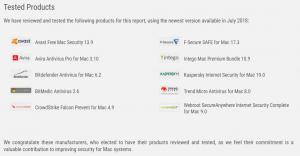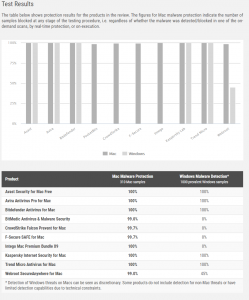Mac Security Software Suites - Do They What They Shall Do? A Test/Review by AV-Comparatives - 2018

Logo AV-Comparatives
The closed Apple ecosystem reduces the risk of malware. This does not mean that Mac users are immune to threats. Phishing does work everywhere, also on Mac!
INNSBRUCK, TYROL, AUSTRIA, August 30, 2018 /EINPresswire.com/ -- It is an often-heard view that macOS computers don’t need antivirus protection. Whilst it is certainly true that the population of macOS malware is tiny compared to that for Windows and Android, there have been instances of macOS malware getting into the wild. Moreover, Apple Mac security needs to be considered in the wider context of other types of attacks.Read the full test here:
https://www.av-comparatives.org/tests/mac-security-test-review-2018/
In addition, it should be noted that Apple themselves ship some anti-malware capabilities within macOS. Firstly, there is “Gatekeeper”, which warns which warns when apps without a digital signature are run. Then, there is “XProtect”, which checks files against known-malware signatures. Finally, apple provide MRT (Malware Removal Tool). Gatekeeper and MRT are essentially invisible to users and have no direct user interface for the user. System updates are installed automatically using the update process. Despite the built-in capabilities, some security experts recommend strengthening the defenses by adding in a third-party antivirus package. There are many good reasons for this. Firstly, the approach taken by Apple might be adequate for well-established malware, but might not respond quickly enough to emerging threats. Secondly, you might want a broader base of malware evaluation.
Some vendors’ macOS security products can detect malware aimed at other operating systems too. Hence an AV program on your macOS computer could effectively handle Windows and Android malware too. Of course, there is no method by which Windows or Android malware could directly infect a macOS device. However, there are scenarios where you might well benefit from scanning for such threats. For example, if you are given a USB stick of photos by one friend, who asks you to make a copy for a second friend. They both use Windows, but you are using a macOS computer. There is Windows malware on the USB stick, and you make a copy of all the files. In this scenario, it is useful to be able to ensure that malware is not inadvertently passed on from one friend to another, even if your own machine is not at risk.
Mac security programs can offer other capabilities too. For example, browser extensions can identify web sites which are potentially phishing locations. Readers should note that Mac users are just as vulnerable to phishing attacks as users of e.g. Windows, as phishing sites function by deceiving the user rather than by altering the operating system or browser.
Other packages might offer VPN (virtual private network) capabilities which can be very useful when you need to operate your computer in an untrusted environment, like a public location, internet café or other place where you are not sure of the integrity of the connection. You might also want to replace macOS’ built-in parental control capabilities with third party tools, if you believe this is more appropriate to your family needs.
Before purchasing a Mac security solution, you also need to decide on the size and scope of the protection you wish to deploy. It might be for a single computer, or to a laptop and desktop. Or you might have a family environment. There might be a mixture of macOS laptops and desktops, but also other devices too like Windows desktops and laptops, along with iOS and Android phones and tablets. For this environment, a broader and more flexible licensing package might well be appropriate.
This could allow you to purchase e.g. 5 licenses and then distribute them amongst your collection of devices. It could also give you the flexibility to transfer licensing from one device to a new item, e.g. if you need to replace an aging Windows laptop with a new MacBook. Some packages offer cloud-based management interfaces. Usually this is to cover the licensing of the packages, but some can also be used to initiate malware scans and device updates and manage parental control capabilities.
Experienced and responsible Mac users who are careful about which programs they install, and which sources they obtain them from, may well argue – very reasonably – that they are not at risk from Mac malware. However, we feel that non-expert users, children, and users who frequently like to experiment with new software, could definitely benefit from having security software on their Mac systems, in addition to the security features provided by the Mac OS itself. Readers who are concerned that third-party security software will slow their Mac down can be reassured that we considered this in our test; we did not observe any significant performance reduction during daily operations with any of the programs reviewed.
As with Windows computers, Macs can be made safer by employing good security practices. We recommend the following:
Do not use an administrator account for day-to-day computing
Use a sandboxed browser such as Google Chrome
Uninstall/disable the standalone Flash Player
Uninstall/disable Java unless it is essential for you
Keep your Mac operating system and third-party software up-to-date with the latest patches
Use secure passwords (the Mac includes the KeyChain password manager)
Deactivate any services such as Airport, Bluetooth or IPv6 that you don’t use
Be careful about which programs you install and where you download them from
Read the full test here:
https://www.av-comparatives.org/tests/mac-security-test-review-2018/
Mediacontact
AV-Comparatives
+43720115542
email us here


